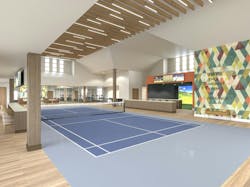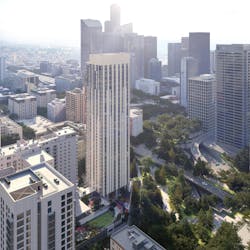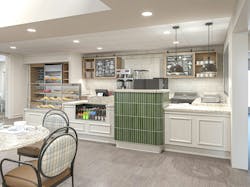Top 10 trends in senior living facilities for 2025
Senior living facilities provide an opportunity for respite for aging adults. These communities have grown into diverse locations where seniors can live out their days however they choose. Diverse amenities and geographic options allow residents to spend their time in a myriad of ways—whether it be gardening outdoors or relaxing inside.
Two years ago, we reported on the top 10 trends in senior living facilities in our 2023 Multifamily Annual Report. There we saw how senior living communities have shifted since their pre-pandemic days. But how have the design and construction trends changed since our last report?
From AI and smart technology that is no longer optional, to holistic strategies for health and wellness, these 10 trends exemplify what a senior living community looks like today.
1. Tighter financing and tougher regulations
The first hurdle firms are having to overcome is the combination of tighter financing and a tougher regulatory environment. These have delayed project starts significantly. Firms like James G. Davis Construction have spent a great deal of time helping their clients remove roadblocks to financing and obtaining permits so that they can accurately plan construction starts together and get the best value when they select trade partners.
Even changes in local parking regulations have greatly impacted community design for senior living projects. Some municipalities still require two parking spaces per unit, which burdens facilities with more parking than they need. However, current trends show that 1.1–1.6 parking spaces per unit suffice, and municipalities are permitting projects with this parking-to-unit allotment more frequently.
With lower parking mandates, the campus hardscape decreases and opportunities for creative landscaping and amenities increase, according to Andrew Heinen, PE, Civil Engineer and Senior Associate, Development Services, Kimley-Horn.
However, when these projects aren’t facing regulatory challenges, we’re seeing some changes in how they’re being built.
2. Refresh, renovation, and rebranding
Architecture firm HKS has noted that acquisitions of existing communities are dominating the market, and with it, a lot of interior refresh and renovation work as well. Mergers and acquisitions have also driven rebranding efforts, with a focus on design that balances familiarity and hospitality to create inviting, homelike spaces.
“Communities are investing in strategic repositioning, refreshing outdated environments to remain relevant in the face of changing demographics and increasing competition,” says Mitch Elliott, AIA, Architect and Principal, RDG Planning & Design; and Dan Schindhelm, AIA, Architect and Partner, RDG Planning & Design.
With these community refreshes comes one impactful innovation: adaptive reuse. One project from RDG involved transforming a struggling hotel into a high-quality assisted living and memory care community. Another saw a dated 1960s apartment complex revitalized into a modern independent living space, complete with an added floor and luxury penthouse units.
A particularly forward-looking RDG project is the redesign of a former skilled memory care facility into a full-scale wellness center for a Texas life plan community. This transformation includes an indoor pickleball court, golf simulator, fitness studios, group wellness areas and infrared therapy, all designed to boost resident engagement and quality of life.
3. Alternative housing/community options
Residents of senior living facilities are not only seeing a refresh in interior design, but in the communities themselves. There is becoming a wide variety of alternative housing types in senior living, from small house concepts to urban communities and university partnerships.
“One of the fastest-growing segments in senior housing is active adult living communities,” says Cynthia Shonaiya, AIA, LEED AP, Principal, Hord Coplan Macht.
Shonaiya is also seeing a shift toward intergenerational communities that prioritize organic interaction across age groups, often integrating senior residences into university campuses, shopping centers, and mixed-use developments.
Similarly, there is a growing trend in the development of senior living communities in urban environments. These allow tenants to be connected to their neighborhood and walk to various amenities and restaurants.
A prime example of this is The Springs at Happy Valley in Happy Valley, Ore. LRS Architects brought this independent, assisted living, and memory care community to life along with an adjacent retail development. Spanning six buildings and connected by pedestrian-friendly plazas, the development provides residents with convenient access to shops, restaurants, and wellness services, reinforcing a strong sense of inclusion and integration with the broader community.
At a larger scale, firms like RDG have seen the planning of senior housing shift toward a neighborhood model—looking beyond single buildings to create campus-style environments with a blend of low- and medium-density housing clustered around a central care and wellness hub.
Regardless of community type, one thing remains key for seniors: accessibility.
4. Accessibility across the board
Accessibility is a concern that is especially pertinent for seniors. As aging in place becomes the norm, senior living communities must look in every nook and cranny for possible accessibility issues and solutions.
Access to buildings, parking lots, outdoor amenity areas, and public sidewalks remain key. This is especially important as access to the outdoors is a rising trend in senior living spaces as well. Firms like Kimley-Horn utilize its multidisciplinary teams to craft diverse mobility solutions that help the entire campus remain consistently accessible for all residents.
While senior living campuses continue to increase accessibility, they’re also making sure to keep things flexible.
5. Flexibility and choice of amenities
One of the biggest changes in senior living is how the dining area is arranged. Gone are the days of the single-use space; a room that serves as a dine-in café in the morning may pivot to become a ‘grab-and-go’ outlet for dinner. Even further, large formal dining rooms are being shrunk to make space for bistro and casual dining venues—ones that rival local restaurants in terms of finishes, vibe, and feel, to provide a respite for residents and their family members.
Across the board, many firms are saying that a shift towards high-end, resort-like amenities are becoming commonplace. Casual dining, formal dining, entertainment, pubs, spas, indoor fitness centers, outdoor fitness activities, and many other perks around campus are aiding in boosting market value and prospective tenant interest for these communities.
One interesting shift for the next generation of older adults is the advent of subscription-based living models. Janice Sanada, Managing Principal, LRS Architects, finds that these models support travel-inspired lifestyles and experiences by offering residents the flexibility to seasonally rotate between campuses and residences. Architectural layouts that support flexible living allow for shared-use or short-term personalization, which is a great way for seniors to connect with extended family, explore new locations or enjoy favorable climates throughout the year.
Though amenities and layouts are changing, sustainability still has staying power.
6. Sustainability stays
Sustainability is not a new topic. However, as the senior living demographic continues to evolve, so do the expectations of this new consumer base.
Eric Harrmann, AIA, Chief Design Officer, AG Architecture, sees that potential residents evaluating community options are homeowners who have invested in environmentally friendly upgrades to their residences, such as solar panels, low-flow fixtures, LED lighting, Energy Star appliances, instant hot water, and radiant floor heating. They expect the community they choose to live in to have made the same level of sustainable investment or more.
LRS Architects’ clients are increasingly investing in energy-efficient systems and durable building materials that minimize environmental impact while maximizing operational performance.
7. Holistic wellbeing
Communities are seeking out ways to differentiate themselves and rebrand into more wellness-centric organizations. They’re stepping into a more holistic approach to wellness where fitness programs, nutritional support, personalized care plans, and mental health services are the backbone of the brand, according to HKS Studio Practice Leader Hillary Owen, IIDA, LEED AP ID+C.
Biophilic design elements are still standout design choices that enhance mental and physical well-being and add a layer to this holistic wellness lifestyle. SmithGroup has been seeing a rise in dedicated wellness suites, meditation and flex spaces, concierge medical services, access to brain health specialists, and strategies to prevent accidents that can inhibit mobility or cognition.
Today’s communities are designed to promote vitality and extend the number of years seniors remain physically and socially active. This includes a wide range of amenities both indoors, such as golf simulators, bowling alleys, and interactive fitness programming; and outdoors, with offerings like pickleball courts, bocce ball, and water-centered activities such as swimming pools, interactive fountains, and pre-stocked fishing holes.
“Importantly, wellness is no longer confined to a single room or program,” says Alexis Burck, AIA, NCARB, Vice President and Senior Living Studio Leader, SmithGroup. “It’s being woven into the fabric of the entire community through a purposeful transition between spaces that keeps residents engaged and active throughout their day.”
However, there are still some hiccups in the senior living industry.
8. Reduction of skilled nursing in the industry
Skilled nursing communities are becoming less common, with the exception of those serving specialized populations such as veterans. As the senior care landscape continues to evolve, there has been a notable shift away from long-term skilled nursing stays and toward short-term outpatient rehabilitation and home-based occupational and physical therapy.
According to Shonaiya, this transition reflects broader trends in healthcare, emphasizing flexibility, independence, and the growing preference for aging in-place whenever possible.
9. Outdoor spaces remain key
Kimley-Horn’s Heinen has seen more assisted living and memory care campuses request memory/healing gardens. The outdoor spaces are designed to relieve stress by connecting residents with nature, while providing spaces for solitude and togetherness.
“These gardens provide our firm with additional opportunities to leverage our creative, experienced landscape architecture teams to cultivate spaces that align with patient, staff, and client needs,” says Heinen.
There has also been an increase in features such as dog parks and walking trails to promote wellness and create meaningful opportunities for social interaction.
10. Smart technology as an expectation
The senior living residents of today are more tech-savvy than ever. They expect their living spaces to support their various electronic devices, cell phones, and apps, so that they remain virtually connected with the outside world. New facilities are integrating the required technology infrastructure from the very beginning of design, and many existing facilities are seeking to upgrade their systems to keep up with the competition, according to Scott Campagna, Vice President of Housing, IMEG.
Smart technologies, including automated lighting and HVAC controls, enhance the quality of life for seniors by providing better air quality and increasing visual comfort.
- Scott Lain, PE, LEED AP, Senior Project Manager & Electrical Engineer, Matern Professional Engineering
HKS’ Owen is seeing a “dramatic uptick” in AI technology integration to support staffing schedules, fall risk, resident behavior tracking, programming, and care planning. By analyzing the data, some of these programs can start to predict issues before they arise which in turn impact the bottom line. Communities are also offering more tech-forward amenities, from streaming on-demand classes to remote wellness programming and digital social coordination tools.
Technology is also playing a key role in wellness. Many operators are implementing platforms that connect residents directly to physicians and therapists, often through concierge wellness programs. Technologies such as circadian rhythm lighting systems are proving especially beneficial for residents with memory impairments, helping regulate sleep patterns and alleviate symptoms associated with sundowning.
SmithGroup’s Burck finds that in some communities this goes as far as partnerships with medical providers that offer services as robust as on-site imaging. These technological innovations help to manage the more routine tasks, thus allowing for more and higher quality one-on-one interactions between residents and the support teams.
About the Author

Quinn Purcell
Quinn Purcell is the Managing Editor for Building Design+Construction. He is a graduate of Idaho State University with a Bachelor of Arts in Communication, and an emphasis in Multiplatform Journalism. He specializes in video, photography, copywriting, feature writing, and graphic design.




